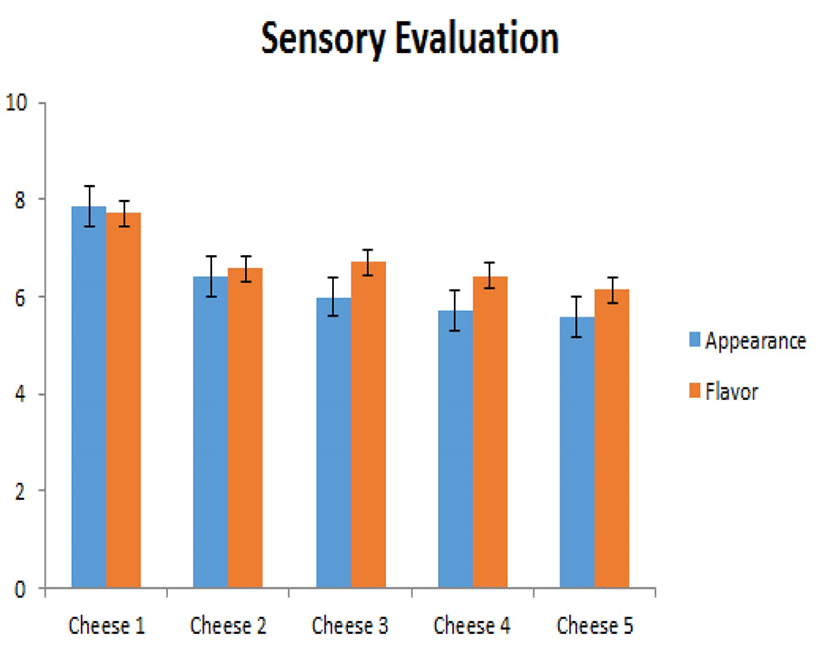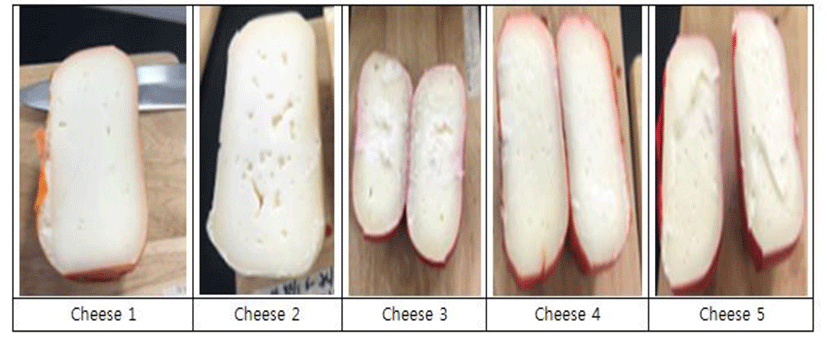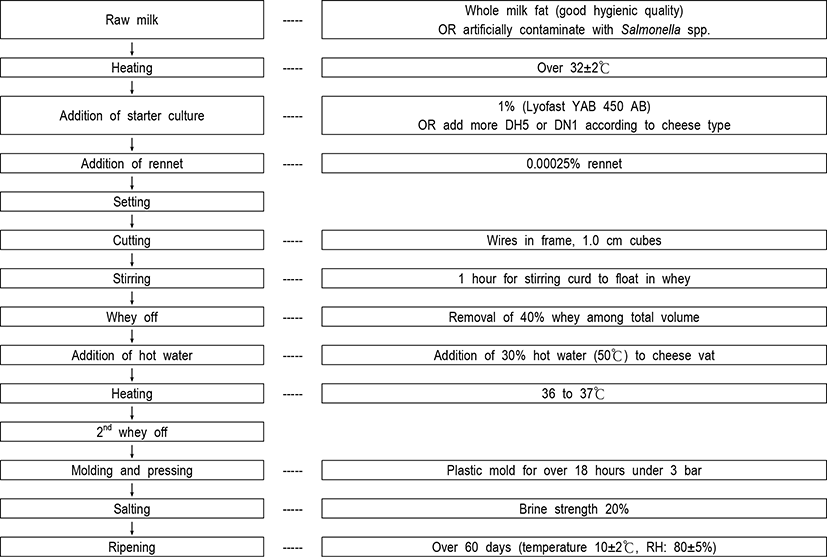서론
일반적으로 치즈는 우유, 산양유, 마유, 양유 등을 원료로 유산균(lactic acid bacteria), 산(acid), 응유효소(rennet), 기타 단백질 응유효소를 작용시켜 casein을 지방과 함께 응고하여 curd를 형성한 후 분리된 curd를 열처리, 가압처리를 하여 유산균 또는 곰팡이에 의해 숙성시켜 얻어지는 식품으로 알려져 있다(American Cheese Society, 2011; Park et al., 2015; Currie et al., 2018). 지금까지 알려진 바에 의하면, 치즈는 원유(raw milk), 제조법, 생산지역 등에 따라 그 형태와 맛, 향이 각각 다르며, 전세계적으로 대략 1,000종 이상의 치즈가 생산되고 있다(Alewijn et al., 2005; Choi, 2011; Monakhova et al., 2013).
자연 치즈는 유산균 혹은 곰팡이와 효소를 이용하여 발효시켜 특유한 풍미와 조직이 형성되는 치즈로서 단백질과 지방이 가공치즈(process cheese)보다 풍부하며, 숙성 중 여러 성분이 분해되어 각종 아미노산, 지방산, 비타민, 칼슘 그리고 phosphorus가 풍부하다(Collins et al., 2003a,b; Lee et al., 2005; Jung, 2012). 또한 자연 치즈는 제조 및 숙성 중에 발생하는 다양한 생화학적 작용에 의한 다양한 풍미관련 물질들이 생성되는데, 그 중에서 유지방은 유산균이나 곰팡이 스타터(starter)의 효소에 의하여 분해되어 휘발성 지방산, 휘발성 carbonyl 화합물 등을 생성하여 자연 치즈 특유의 중요한 풍미성분으로 나타난다(Leuven et al., 2008; Kim et al., 2015). 또한 자연치즈의 숙성 중 단백질 분해는 아미노산과 펩타이드 등의 생성에 대한 직접적인 기여를 하며, 아미노산의 대사작용에 의해서 생성되는 아민, 산, 티올, 티올에스테로 등의 직접적인 영향을 줄 뿐만 아니라, 치즈 커드(curd) 중의 응유효소 및 plasmin의 잔존량, 염(salt)에 대한 수분함량의 비, 숙성온도와 습도 및 치즈의 pH, casein 중의 칼슘잔존량 등에 의하여 영향을 받는다(Marilley et al., 2004; McSweeney, 2004; Van Leuven et al., 2008; Vanevenhoven, 2012).
네델란드에서 가우다라고 불리는 Gouda 치즈는 네덜란드의 Rotterdam 부근 Godua 지방에서 전통적으로 만들어지는 자연치즈로서 네덜란드의 유명한 Edam 치즈와 함께 주요 수출 농산품의 하나이다(Honish et al., 2005; Van Hoorde et al., 2008; D’Amico et al., 2010; Gill and Oudit, 2015). Gouda 치즈의 특성을 살펴보면, 수분 함량은 42∼55%, 지방 함량은 25∼46%, 단백질 함량은 22∼35%, salt 함량은 1.0∼1.5%이며, 최소 2∼6개월 이상 숙성시키는 전형적인 숙성형 자연치즈로서 신맛과 고릿한 향(rancid flavor)를 가지며, 표면은 약간 딱딱한 원형(또는 원반형)의 모양으로 노란색을 띈다(Davila et al., 2006ab; McCollum et al., 2012). 일반적으로 Gouda 치즈는 담황색의 파라핀이나 왁스 등으로 포장하지만 Edam 치즈는 적색의 파라핀이나 왁스로 포장을 한다. 또한 지방함량이 Gouda 치즈가 Edam 치즈보다 다소 높은 것을 제외하면 Gouda 치즈와 Edam 치즈의 제조공정과 특성은 유사하다(Kim, 1992; Lee et al., 1996ab; Fox and Wallace, 1997; Messens et al., 2000; Van den Berg et al., 2004; Harbutt, 2015). Gouda 치즈는 소비자의 기호에 맞는 풍미형성과 전형적인 조직을 얻기 위하여 장기간 숙성기간이 필요한데, 이러한 치즈의 숙성은 산화-환원반응, 인산화반응, 탈인산화반응, 탈아미노반응, 지방분해, 단백질분해, 유당분해 등 다양한 생화학적 반응에 통해서 다양한 풍미관련 성분이 생성되어서 소비자의 기호에 맞게 된다(Yvon and Rijnen, 2001; Van Kranenburg et al., 2002; Yang, 2009; Colonna et al., 2011).
따라서 본 연구의 목적은 양질의 원료로 제조된 비살균 Gouda 치즈와 식중독세균인 Salmonella spp.를 인위적으로 오염시킨 원유로 제조한 비살균 Gouda 치즈의 60일 숙성기간 동안 숙성도에 따른 pH 변화와 관능검사 관찰하기 위해서 본 실험이 진행되었다.
재료 및 방법
경기도 연천지역에서 집유한 신선한 원유에 starter로서 Str. thermophilus, Str. lactis, L. bulgaricus, L. casei의 혼합균주(Lyofast YAB 450 AB, Sacco srl., Codaragok, Italy)와 rennet(Mysecoren Maysa GIDA, Turey)를 사용하여 Fig. 1과 같이 Gouda 치즈의 제조방법에 따라 건국대학교 수의과대학 Center for One Health의 공중보건학실험실에서 제조한 Gouda 치즈를 숙성실(온도: 10±2℃, 상대습도: 85±5%)에서 60일 이상 숙성시키면서 공시재료로 사용하였다 (Kim, 1992; 서와 송, 2017).
본 실험에서는 비살균 Gouda 치즈의 관능검사 특성을 알아보기 위해서 총 5개의 다양한 Gouda 치즈가 제조되었으며, Table 1에 자세하게 정리되어저 있다.
특히, Cheese 3, 4, 5에는 원유에 식독중균으로 알려진 살모넬라균을 인위적으로 접종하여 최종 완성된 비살균 Gouda 치즈의 관능검사에 미치는 영향을 관찰하였다. Salmonella spp.는 건국대학교 수의과대학 Center for One Health에서 보유하고 있던 식품분리균주를 사용하였으며, Nutrient agar(Oxoid, Hampshire, U.K.)에 해동된 균주를 도말하여 37℃에서 호기적으로 24시간 배양한 후 배양된 집락 중 단일집락을 선택하여 Tryptic Soy Broth(Oxoid)에서 37℃에서 24시간 배양하였으며, 3번 이상 계대배양한 균액을 희석하여 접종액으로 사용하였다.
또한 Gouda cheese 4와 5에 유산균인 Lyofast YAB 450 AB외에 Kefir에서 분리한 유산균인 DH5와 DN1를 각각 추가로 첨가하였다. 이것은 항미생물 활력을 가진 DH5와 DN1의 첨가를 통해서 Gouda 치즈의 관능에 어떤 영향을 주는 지를 알아보기 위해서이다. 유산균인 DH5와 DN1는 MRS(Difco, Detroit, MI, USA)에 도말하여 36℃에서 48시간 배양 후 MRS broth에 계대하여 사용하였다.
pH 측정은 생리식염수(saline)와 치즈를 2:1의 비율(saline:cheese = 20 mL:10 g)로 분쇄용 tube에 넣어 균질기에서 균질한 다음 pH meter(Orion 420, USA)를 사용하여 측정하였다.
Bodyfelt et al.(1965)의 방법을 변형시켜 풍미, 조직, 외관, 색깔, 굳기 등의 5개 항목에 대하여 훈련된 검사원 10명에 의해 평가하였다. 평가는 각 항목에 대하여 매우 좋음(10점), 좋음, 중간, 나쁨, 매우 나쁨(1점)을 기준으로 하여 실시하였다.
결과 및 고찰
원유의 pH는 보통 6.8 내외인데, 본 실험에 사용된 원유의 pH도 6.7±0.4로 나타났으며, 살균한 원유에서도 비슷한 pH 값을 보였다(data not shown). 비살균 Gouda 치즈 제조시 원유의 pH는 지속히 감소하여 대략 pH 5.2±0.5를 보였다. 60일 숙성한 후 비살균 Gouda 치즈의 모든 샘플에서 pH 값은 0 day보다 증가의 값을 보였으며 pH 5.5±0.3을 나타내었다(data not shown).
Kim (1992)은 Gouda 치즈 숙성기간에 따른 품질에 관한 연구에서 제조직후에는 pH가 5.16이었으나, 숙성 1개월 후에는 pH 5.41, 숙성 2개월 후에는 pH 5.58 그리고 숙성 6개월 후에는 pH 5.81로 상승경향을 보였다. Lee et al.(2016)은 착유방식이 목장형 유가공으로 제조된 Gouda 치즈의 품질 특성에 미치는 영향 연구에서 6개월 숙성 후 pH의 값은 5.59에서 5.78까지 보였지만 유의적인 차이는 없었다.
Park et al.(2014)은 Lactobacillus rhamnosus_p1을 이용한 절단형 Gouda 치즈 제조방법 및 숙성 중 품질특성 연구에서 Gouda 치즈 숙성 과정 중의 pH 변화를 보고하였다. 대조구(control)는 숙성 초기 pH 5.30에서 숙성 3개월째 pH 5.20으로 감소하였다가 그 후 숙성기간 동안 증가하여 pH 5.52까지 증가하였으며, L. rhamnosus_p1을 처리한 실험구는 숙성 초기 pH 5.29에서 숙성 2개월까지 약간 감소하여 pH 5.22였다가 숙성 3개월째부터 증가하여 숙성 5개월째에 pH 5.61까지 증가를 보였다. 이것은 숙성 초기 curd 내에 잔존하는 유당분해에 따른 유산의 생성으로 인해 pH가 감소하고, 그 후 pH의 상승은 단백질 분해와 암모니아 생성에 따른 상승이라 보고하였다(Lee and Nam, 1996a,b).
또한 Visser and De Groat-Mastert(1977)는 치즈내 pH의 증가 이유를 유산의 분해, 비활성 성분, 치환물의 생성, 초산, carbonic acid 와 같은 약하거나 완전 해리되지 않은 산의 생성 등과 단백질 분해에 의한 알칼리 물질의 유리 등에 의한 것이라고 보고하였다.
일반적으로 Gouda 치즈의 경우, 숙성기간이 증가함에 따라 수분은 감소하고, 조단백, 조지방, 조회분, pH는 높아진다고 보고하였다(Kim, 1992). Van den Berg et al.(2004)은 Gouda 치즈는 반경성치즈의 특성을 가지며, 일반적으로 지방을 제외한 성분 중 pH 값은 보통 4.9∼5.6이며, 수분 함량은 평균 53∼63%이라고 보고하였다.
본 실험에서 비살균 Gouda 치즈의 pH 값도 기존의 다른 연구에서 나타난 pH 결과와 비슷한 경향을 보였다.
비살균 Gouda 치즈와 살균 Gouda 치즈 샘플에 대한 60일 숙성후의 풍미와 외관의 변화는 Fig. 2에 나타나 있다.

치즈의 품질은 풍미(맛과 향기), 조직(경도, 부서짐성, 응집력, 신장성, 절단성 등), 그리고 외형(색깔, 균일성, 치즈눈과 다른 쪼개짐, 그리고 곰팡이의 존재 유무)에 의해서 결정된다(Fox et al., 2000).
본 실험에서 관능검사에 이용된 샘플은 총 5개이다. Cheese 1과 Cheese 2는 양질의 원유로 제조된 비살균 Gouda 치즈이며, Cheese 3부터 5까지는 인위적으로 Samonella spp.가 오염된 원유를 이용하여 비살균 Gouda 치즈를 제조한 샘플이다(Fig. 3).

먼저 풍미를 비교해 보면 Cheese 1이 제일 높은 점수를 보였으며, Cheese 5가 가장 낮은 점수를 보였지만 Samonella spp. 오염이 비살균 Gouda 치즈의 풍미에 큰 영향을 주지는 못하였다(Fig. 2).
왜냐하면 일반적으로 치즈를 오랜 기간 숙성시킬수록 맛과 풍미는 좋아지며, 미생물학적이 오염도 역시 크게 개선되는 것으로 평가되기 때문이다.
60일 이상 숙성기간을 거친 비살균 원유로 제조된 치즈는 맛과 풍미가 살균된 원유로 제조된 치즈에 비해 우수할 뿐만 아니라, 미생물학적인 안전성 또한 좋다고 보고되었다(Kim et al., 2015). 따라서 본 실험의 관능검사에서도 비슷한 경향을 보였다.
다음으로 Samonella spp. 오염에 따라 외관에는 큰 영향을 주는 것으로 나타났다(p<0.05). 왜냐하면 자연치즈는 숙성 중에 미생물 및 효소에 의해 다양한 이화학적 및 생화학적 반응이 일어나고 많은 성분들이 생성되며, 제품의 풍미, 외관, 영양가 등에 기여하기 때문이다(Kim, 1990; Fox and Wallace, 1997; Jung, 2012). 따라서 치즈의 최종 품질과 소비자의 선호도에 결정적인 영향을 줄 수 있는 자연치즈의 숙성은 매우 중요하기에 최상의 치즈를 만들기 위한 치즈 제조 기법의 중요성을 인식하여 지속적인 연구가 진행되어야 할 것이다.
그리고 본 실험에서 제조된 다양한 비살균 Gouda 치즈들의 조직과 색깔 비교에 있어서는 큰 차이가 없는 것으로 조사되었다(data not shown).
일반적으로 치즈의 조직은 여러 효소의 작용에 의하여 숙성기간 동안 계속 변하게 되는데, 대략 2단계로 나눌 수 있다. 먼저 1단계는 치즈 제조 직후 1∼2주로 이 기간에는 casein의 결합이 가수분해되면서 약해지며, 그 다음 2단계에서는 단백질 분해가 점진적으로 이루어지면서 두 개의 이온 그룹이 생성되는데, 이 때문에 조직의 수분이 감소하고, 단백질 사슬은 견고해짐으로써 조직이 단단하면서도 유연해진다(Creamer and Olson, 1982; Exterkate et al., 1987). 따라서 치즈 조직은 이 casein 연결(network) 사이에 지방구 등이 갇혀 있는 형태이며, 단백질뿐 아니라 지방, 수분 등에 의해서도 영향을 많이 받는다(Jack and Paterson, 1992). 숙성이 진행됨에 따라 조직 특성도 변하게 되는데, Gouda 치즈의 경도와 저장성이 숙성 2∼3개월에 유의적으로 감소한다(Vanevenhoven, 2012). 경도는 단백질 분해와 유의적인 상관관계가 있으며(Fedrick, 1987), 응집성의 증가는 casein 연결의 상대적으로 빠른 가수분해와 관련이 있고, 탄성은 숙성과정 중에서 para K-caseinate 분자의 분해에 따른 방출에 따라 숙성이 진행될수록 감소한다(Kanawjia et al., 1995). 치즈의 pH는 단백질뿐 아니라, 인산칼슘의 용해도와 수분에 영향을 주고, 염도 또한 단백질 분해에 영향을 주어 조직 특성에도 영향을 주며, 치즈의 수분과 지방은 경도나 탄성에 영향을 준다(Green et al., 1986; Luyten, 1988).
보통 치즈의 조직 특성을 알아보기 위해서는 치즈시료를 일정한 크기로 절단한 후 texture analyzer을 이용하여 Texture Profiling analysis를 분석한다. Gouda 치즈의 조직특성 연구에 의하면, 대조구(control)의 경도는 59.65, 응집성은 0.65, 점착성은 38.74, 탄성은 0.67, 저작성은 26.21로 분석되었으며, 실험구인 콜레스테롤을 제거한 Gouda 치즈에 비해 응집성, 점착성, 저작성은 유의적으로 낮았고, 경도와 탄성은 두 처리구 간에 차이가 없었다(Jung, 2012). 그리고 목장형 유가공 농가에서 제조한 Gouda 치즈의 TPA 결과에 의하면 경도는 3.82에서 9.78이고, 부착성은 1.65부터 11.13이었으며, 탄력성은 0.83에서 0.97이고, 응집성은 0.34부터 0.47이며, 복원성은 0.05에서 0.14이고, 점착성은 1.52에서 3.96이며, 저작성은 1.32부터 3.71의 값을 보였다(Lee et al., 2016). 그리고 고압 처리된 Gouda 치즈의 물성에 관한 연구에서 숙성기간이 경과함에 따라 압력에 따른 물성의 차이가 감소한다고 보고되었다(Messens et al., 2000). 또한 숙성 기간에 따라 경도는 증가하지만 응집성이나 부착성은 차이가 없으며, 치즈 제조에 사용되는 유산균에 따라 치즈조직의 특성에 차이가 나타났다고 보고하였다(Kanawjia et al., 1995; Lee et al., 2005).
치즈에 제일 중요한 것은 치즈의 향미로 알려져 있다. 일반적으로 치즈의 향미는 매우 복잡 다양하며 각 치즈마다 다양한 숙성과정을 통해서 단백질, 지방, 당 분해에 의해서 많은 영향을 받을 뿐만 아니라, 분해과정 중의 원유, 렌넷, 유산균, 다른 유산균(NSLAB), 기타 세균, 곰팡이, 효모, 숙성 조건 등의 다양한 요인들에 의해서도 영향을 받는다(Marilley and Casey, 2004; Smit et al., 2005). 또한 Ruyssen et al.(2013)은 치즈를 염지할 때 사용되는 Salt의 종류에 의해서도 향미에 많은 영향을 받는다고 보고하였다.
치즈의 숙성과정 중에 지방의 분해에 의해 발생하는 다양한 유리지방산들은 자극적인 냄새에서부터 치즈 고유의 다양한 향과 풍미에 기여하며, 특히 이탈리아 경성 치즈에서는 유리지방산들이 풍미에 큰 영향을 준다(Collins et al., 2003b). 더 나아가서 치즈의 지방은 향미를 나타내는 지용성 성분의 용매 역할을 한기도 한다.
정리하면 본 실험에서는 인유적으로 Samonella spp.를 오염시킨 원유로 제조된 비살균 Gouda 치즈에서 풍미에 많은 영향을 받는 것으로 나타났다.
요약
2018년부터 한국에서도 비살균 우유로 제조된 치즈의 생산과 유통이 허용되기 시작하였다(식품의약안전처, 2016a,b). 따라서 본 연구에서는 한국인들이 가장 많이 선호하는 Gouda 치즈를 선정하였으며, 비살균 원유로 제조된 60일 이상 숙성치즈의 관능검사를 중심으로 실험을 진행하였다. 본 실험에 사용된 원유의 평균 pH는 6.7±0.4이며 살균된, 원유에서도 비슷하게 나타났다. 비살균 Gouda 치즈의 pH는 5.2±0.5를 보였으며, 60일 숙성한 후 비살균 Gouda 치즈는 pH 5.5±0.3을 나타내었다. 본 실험에서 관능검사에 이용된 샘플은 총 5개이며, Cheese 1부터 Cheese 5까지이다. 풍미를 비교해 보면 Cheese 1이 제일 높은 점수를 보였으며, Cheese 5가 가장 낮은 점수를 보였지만 Salmonella spp. 오염이 비살균 Gouda 치즈의 풍미에 큰 영향을 주지는 못하는 것으로 나타났다. 반면에 Salmonella spp. 오염된 원유로 제조된 비살균 Gouda 치즈의 외관에는 좋은 않은 영향을 주는 것으로 나타났다.







